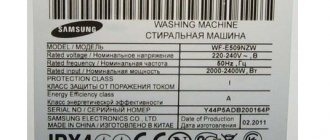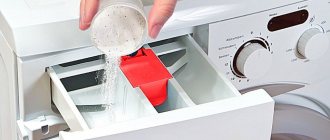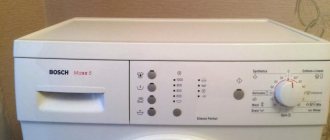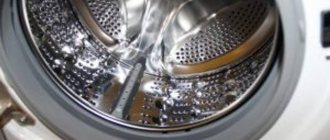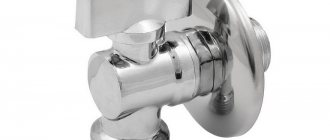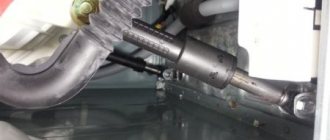After purchasing a new washing machine, users are faced with the question of what to do with the old machine. In large cities there are companies that buy used household appliances. This is very convenient - representatives of the organization themselves take out and remove the equipment, freeing the owners from these worries.
There is another way to get rid of equipment - to turn over some components for metal, and sell some of the parts. Let's figure out how much, for example, a stainless steel washing machine drum weighs. Is there any point in bothering with disassembling the device?
What does weight depend on?
Two externally identical automatic machines from different manufacturers or different models of the same brand can differ significantly in their weight.
It’s not difficult to understand why this happens - inside identical-sized cases there can be completely different “fillings”. Most of all, the weight of the device is affected by the following:
- body material and configuration,
- volume and material of the tank,
- drum parameters,
- number and mass of counterweights.
The most significant contribution to the total mass of the device is made by the counterweights. These are parts of various shapes, the main task of which is to ensure that the machine achieves maximum stability. But the characteristics of the material from which other parts are made also make a significant contribution.
It’s easy to guess that a body made of plastic or composite materials is much lighter than steel. A stainless steel tank is an order of magnitude heavier than a similar one made of plastic. It is easy to calculate how much a stainless steel drum weighs and how this affects the characteristics of the device as a whole.
It is worth noting the fact that in most cases, compact devices with the same capacity have more weight. This is due to the fact that the body, which has a small contact area with the floor, is easier to “lose,” so manufacturers are forced to forcibly make the machine heavier, lowering the center of gravity using counterweights.
There is a wide range of washing machines on the market, differing markedly in a number of parameters, including weight. The lightest of those that can be bought weighs no more than 30 kg, the weight of the heaviest, not counting laundry equipment, is about 100 kg. On average, this figure fluctuates in the range of 50-70 kg.
The difference in weight between washing machines of different models can be tens of kilograms. The weight of the washing machine is determined by several factors, including the body material, tank volume, type of installation, as well as the presence of additional functions that require additional equipment (for example, drying clothes).
Experts say that the weight of the washing machine is largely influenced by counterweights, which are needed to properly balance the drum. The weight of these elements may vary depending on the manufacturer - hence the difference in weight between models of the same dimensions.
Which is better: a heavy or light machine?
Buyers want to buy a relatively light unit, but at the same time there is a risk that it may vibrate strongly during spinning. This may cause it to malfunction. It is the weight of the device that affects the ability to withstand strong vibration, which is why engineers of many brands install balancing on their products.
Attention! The heavier the washing machine, the more stable it is.
More and more units equipped with electronic balancing are appearing on the market. This technique autonomously reduces the spin speed if necessary. Experts are convinced that weights should not be abandoned, since the mass of the SMA is important for washing to be safe and without incident.
A lightweight washing machine can be built into a kitchen unit and is mobile. But at the same time, they have their drawbacks:
- high cost;
- the drum has a capacity of no more than 3.5 kilograms;
- high vibration;
- the laundry is wrung out poorly;
- the SMA drum cannot be called spacious;
- the quality of washing is unsatisfactory;
- quickly becomes unusable.
Heavy washers are practical, quiet and safe. But problems may arise during transportation.
Washing unit weight
Many consumers do not pay due attention to this parameter, believing that it does not affect the operation of the product and is only interesting during transportation, but they are deeply mistaken; The weight of the washing machine is of great importance during the spin mode: the greater the weight of the product, the less the body vibrates at high drum rotation speeds. The weight of the machine can vary between 30-100 kg, but this cannot be determined by external data.
It is important! The heavier the product, the more stable it is. This is the main advantage of heavyweights, but transporting them is not an easy task.
The basis of the total mass is made up of balancing weights, which ensure optimal stability of the product; they are made from a mixture of sand and polymers or cast iron. Their total weight should be much greater than the total weight placed in the laundry drum (we mean the wet equivalent, not the dry) - only under this condition will the spin mode occur without causing unwanted vibrations and moving the machine body along the floor.
Will the revenue from scrapping the washing machine be significant?
Unfortunately, it is not possible to talk about the big money received for the returned residual parts from the washing machine. However, even the small money received for this unit will at least partially compensate for the purchase of a new one. After all, most often we simply throw away broken washing machines if they cannot be repaired.
This solution is most beneficial for enterprises where this equipment is used en masse. These are laundries, hotels and other establishments in which washing is an essential element of daily activities. There, industrial machines weigh much more, contain more useful metals, and therefore, when they are written off, there is an opportunity to capitalize well on their residual value.
Tips for choosing
- Narrow washing machines are very popular among owners of small apartments. But such washing machines have one drawback that you need to be aware of: a small support area, which creates strong vibrations during spinning. Therefore, manufacturers often add additional weight to narrow models, making them more stable.
- When choosing a washing machine, pay attention to such a factor as the presence of auto-balancing. This is a relatively new feature that manufacturers equip the latest models of washing machines with. It controls the rotation speed of the drum, which avoids vibration and increased noise.
With a diverse range of washing equipment, choosing the best option is quite difficult; the buyer must take into account the following main points:
- Narrow units easily fit in small apartments, so they are in high demand, but we must remember that they have a significant drawback - a rather small support area. Manufacturers deliberately make such products heavier to prevent strong vibration from occurring at high drum speeds.
- When choosing the optimal model for your apartment, pay close attention to the presence of automatic balancing - this is a new option that was introduced quite recently. Its task is to control the rotation speed and reduce it when strong noise and vibration occur.
- The optimal weight of a standard front-loading machine should not be lower than 50 kg, this allows it to remain stable, and when it weighs about 80 kg, the user has no problems moving it within an apartment or when moving.
Each specific model has its own weight restrictions, since the weight of the product directly depends on the size of the drum load and the dimensions of the housing.
Advantages of stainless steel tanks
Most automatic washing machines have a plastic tank material. They are cheaper, lighter and less noisy. They have good thermal insulation, which means the device consumes less electricity. But why are consumers willing to pay for more expensive stainless steel?
Advantages of washing machines with stainless steel tanks:
- Strength. Unlike plastic, steel does not crack from impacts. Plastic is very fragile and can crack if struck by a metal object - if one gets inside the washer due to the user’s absent-mindedness.
- Durability. This factor is directly related to the previous one. Thanks to the increased strength of steel, SMAs are able to work for many years.
Stainless steel also has disadvantages:
- Increased noise. Steel elements are not able to dampen noise and vibration.
- High cost of SMA. The price of steel affects the total cost of the device.
- High energy consumption due to poor thermal insulation.
Tank and drum - what's the difference?
Users often confuse these two concepts. It is worth understanding this issue so as not to make a mistake in your choice:
- The drum is the element in which the laundry is placed. It is he who rotates during washing. All washing machines, regardless of brand, type and model, are available with a stainless drum . It is made from high-strength sheet steel.
- Tank is a container with a drum inside. Water and detergent are poured into it, from where they enter the drum through the holes.
The tank experiences heavy loads:
- water is heated in it;
- exposure to aggressive chemicals;
- Small objects may fall into it from the drum.
Often, when this unit breaks down, consumers change the washing machine - replacing it is too expensive. It's easier to buy a new device.
Weight of standard washing equipment
The weight of modern washing equipment varies between 30-100 kg and depends on the class, functional features and built-in equipment. Up to 50 kg there are miniature products that can be built under the sink or in a special compartment of the kitchen unit, more substantial specimens weigh up to 70 kg, and then there are heavyweights with high spin speeds.
We suggest you familiarize yourself with How to wash a down jacket in an automatic washing machine
Need to know! The exact weight of the machine is indicated in its technical passport, so when choosing a model, carefully read all its data; no specialist will give you more detailed information.
Washing appliances with a depth of more than 50 cm
There are many washing machines with a load of 8 kilograms. The dimensions are equal: width - 60 centimeters, height - 85 cm. Standard depth - 55 cm. They can spin clothes and have 13 or more programs. Drum volume is more than 50 liters.
Automatic washing machines with these parameters weigh:
- LG F1096TD3 - 62 kg;
- Samsung WW80J5545FX - 61 kilograms;
- Whirlpool AWOC 0714 - 68 kg.
Among the machines with a depth of about 60 centimeters, there are models with a maximum load of ten kilograms. The width of such models is 60 cm, the height is 85 cm. These devices have a modern design and many additional functions: steam treatment, self-cleaning function. The Samsung and Elgie models can be connected to a smartphone. This will allow you to start the wash remotely or change the program without leaving the couch or while on the road from work.
The weight of front-loading automatic washing machines with a maximum load of laundry of 10 kilograms is:
- LG F4J9JS2S - 68 kg;
- Samsung WW10M86KNOA - 83 kg;
- Hotpoint-Ariston RZ 1047 B EU – 75 kg
Why does the weight of a washing machine vary?
On the market today you can see a large number of different washing models. typewriters And what’s interesting is that their weight can vary significantly. It seems like there are 2 cars with different widths and heights, but they have the same weight, how can this be?
Most washing machines have approximately the same weight
. This is not always the case; sometimes even very narrow washing machines weigh more than their standard “brothers” of a fairly large size. The unit contains a large number of different components, irreplaceable devices and elements. Some of them are especially massive, taking up a significant volume of the entire car.
The main weight of a modern model comes from counterweights - they are the ones who make the household appliance heavier, so different manufacturers can install counterweights of different weights. That is why 2 variations of the same dimensions and characteristics can have different weights. The only thing you need to think about is which washing machine to choose.
Subtleties of washing
Why is it so important to know how much the clothes or linens you need to freshen weigh? Why are different machines designed for different weights and what happens if these parameters are not followed?
Surely you noticed that when you filled the drum to capacity, the washing results did not live up to expectations, and the drum itself made a terribly loud noise in the process and literally “shaked.”
Drum overload is unacceptable
, because:
- You get poor quality washing and rinsing. Items may have powder stains or lingering stains, which you then have to wash with your own hands.
- The service life of the machine is reduced, its functional parts (drive, drum fasteners, etc.) quickly fail.
A half-empty drum also does not increase the service life of the equipment and is undesirable
It is important that the drum load exceeds at least 1/3 of the manufacturer’s recommended rate
Dependence of weight on fabric type
Typically, the operating instructions for a specific model contain detailed information not only about functionality, but also useful information for the housewife. For example:
- approximate weight of dry laundry for a washing machine;
- recommended weight of laundry for one-time washing depending on the type of fabric;
- recommendations on temperature conditions and programs.
But if such an instruction manual is lost, then it would be useful to remind you of the weight of this or that material:
| Image | Description |
| |
| Products made from synthetic fabrics should be washed at a temperature of no more than 60 °C. The maximum weight is calculated from the formula x/1.5, where x is the maximum load of the drum of your machine. | |
The maximum weight of cotton laundry is equal to the maximum drum capacity, but washing recommendations and weight may vary:
|
Dependence of weight on the type of things
If your machine is not the latest generation or the price of your model is in the economy segment range, then it most likely does not have additional functions. However, this does not at all prevent her from carrying out her main task to the fullest. However, in this case, you will have to take into account the degree of its workload yourself.
The table contains information about the approximate weight of linen and clothing. For convenience, I advise you to print it out and hang it on the body of the machine:
| Photo | Instructions |
Bed dress
| |
Kitchen and bath accessories
| |
Cloth
|
Medium models
Washing machine repair specialists say that the best models are Indesit and LG, which perfectly balance weight with functional features. Below is a list of different models with total weight, front loading:
- Indesit - for models from Italy, the weight depends on the depth, standard ones with dimensions of 85x60x42 cm weigh from 62.5 to 62.8 kg, narrow versions with a depth of 33 cm - 52.5 kg.
- Ariston - Italian craftsmen have achieved a slight variation in weight depending on the dimensions, it is 63-70 kg.
- Samsung - Korean engineers, with the help of innovations, have made the maximum weight of their products within the following limits, depending on the depth: 55-65 kg.
- Kandy - product weight with standard parameters - 63.5-64.5 kg.
- Bosch - the famous brand from Germany weighs within the following range: 64-66 kg.
- LG is a well-known brand from South Korea, here everything also depends on the depth: 36-64 cm - respectively 56-73 kg.
- Zanussi - from Slovenia, weight varies between 52.5-54 kg.
Experts state the fact that top-loading washing units sometimes weigh much more than their counterparts, although they have narrower shapes; this is done in order to prevent the effect of rocking the product at high spin speeds.
Which washing machine is better - top-loading or front-loading?
WLG 20061 is a front-facing machine with an intelligent automatic control system for water and electricity, which allows significant savings without compromising the quality of washing. Convenient panel with indicators, control buttons and hints and symbols in Russian. The progress of programs is indicated by indicators.
Overall dimensions - 60x45x85 cm. Spin speed - up to 1000 rpm. Sensors are installed for water dosage and for determining the optimal time for program execution.
Advantages:
- Automatic control of imbalance of loaded items;
- Three-dimensional wetting of things - “3D-AquaSpar”;
- Effortless and noise-free electromagnetic loading door lock;
- The cuvette has a self-cleaning mechanism;
- Control over excessive foaming;
- High-quality spinning of washed clothes;
Control panel of the washing machine Bosch WLG 20061 - Sound signal about completion of work.
Flaws:
- Long washing programs;
- Each program imposes its own restrictions on the downloadable volume of things.
WLG 20260 Wff is a front-facing model rich in advanced functionality. Loads up to 5 kilograms, classified as class A for the quality of washing things. Spin speed 1000 rpm. Economical water consumption (40 liters of water and 0.9 kW of electricity per cycle).
Advantages:
- Large display of digital design with information about the progress of programs;
- Multifunctional control panel with many settings;
- 100% washing out of residues of washing powder and detergents when rinsing;
Washing machine Bosch WLG 20260 Wff - Delicate hand wash at high water level in a gentle cycle;
- Night wash mode without spinning and with additional rinsing, after which a pause is activated;
- Delay of starting the washing machine with an interval of possible time setting - a day;
- Built-in voltage stabilizer;
- Child protection;
- Ability to adjust any program;
- Compactness;
- Leak resistance system.
Flaws:
- The heating element is made without the use of ceramics;
- Small drum.
WIS 24140 – automatic machine with built-in option. Loading up to 7 kg. Drum rotation speed is 1200 rpm. Overall dimensions - 82x60x57 cm.
Washing machine Bosch WIS 24140
Advantages:
- 15 basic washing programs, including removing dirty stains;
- The “Easy Ironing” option prevents the items being washed from becoming wrinkled;
- Leak protection system;
- Control of imbalance and excessive foaming;
WVH28442OE – automatic washing machine with clothes drying option. Loading up to 7 kilograms. The spin speed can be adjusted in the range from 400 to 1400 rpm. Overall dimensions - 85x60x59 cm.
Washing machine Bosch WVH28442OE
Advantages:
- 16 programs and two drying options (intensive and gentle);
- Opening the loading hatch 180 degrees;
- Reloading laundry during work;
- Child protection;
- Leak protection and foam control;
- Hatch door locking and imbalance control.
We invite you to familiarize yourself with the Water purification filter for the washing machine
Perhaps the first thing a potential buyer pays attention to is the brand and manufacturer of the device. This is a justified approach, because the reliability of the device and a number of its main characteristics largely depend on the brand. SAMSUNG, Indesit, LG, Ardo and others are a guarantee of high product quality, reliability and durability.
Most manufacturers offer models of various “weight categories”, trying to cover the market as much as possible. Thanks to this, it is easy to select a device “by weight” in the catalog of any manufacturer.
Samsung
Most Samsung washing machines weigh 55-65 kg. Innovative solutions by engineers from South Korea made it possible to create a medium-weight device with excellent consumer characteristics.
A striking example is SAMSUNG WF60F1R2E2WD. This is a free-standing machine weighing 57 kg. It belongs to the narrow class, has a depth of only 45 cm, and is designed to load up to 6 kg of laundry.
Indesit
The weight of most common Indesit models is in the medium weight category. Most devices have a mass in the range of 50-80 kg, which can be safely called the “golden mean”. A car with similar indicators:
- has sufficient stability,
- not subject to excessive vibration,
- has average “transportability” indicators.
With all this, these devices have all the necessary functionality and sufficient power to perform washing of any level of complexity. Almost all Indesit models can wash delicate linen and winter jackets with equal success.
Example – INDESIT IWSE 61253 C ECO. This is an excellent solution for the average family. With a depth of 42 cm, the device belongs to a narrow class. Due to its fairly large weight - 61 kg and a low center of gravity, it has good noise levels and excellent stability.
Bosch offers solutions for every need. Front-loading and top-loading devices are available. It will not be difficult for a buyer to buy a car of a light class and a real “heavyweight”. Regardless of the type of device, the manufacturer guarantees excellent quality and good consumer characteristics.
When choosing a car for your home, you should pay attention to an additional function - an automatic balancing system. This useful option ensures that even modest weight machines are free from excessive noise and vibration.
When choosing a device for a large family, you should pay attention to the full-sized washing machine BOSCH WAB 24262. Its impressive dimensions, its depth is 55 cm and its weight of 66 kg provide excellent stability and low noise level during washing.
LG products are consistently popular in the market. The main line of the manufacturer is cars that are in the “golden mean” of the weight rating. The manufacturer offers a variety of models, both front-loading and vertical-loading. In any case, the machine is guaranteed to cope with the responsibilities assigned to it. Transportation will not cause any particular difficulties, and stability will be beyond praise.
As an example, we can mention the LG F-1096ND3. This device has a mass of 60 kg, front loading, and can wash up to 5.5 kg of laundry in one go, which is optimal for the average family.
Kandy machines are well-deservedly popular among users all over the world. With a fairly affordable price tag, devices from this manufacturer are an excellent choice for a family with an average income.
One example of products from this brand is Candy GVW 264DC. The front-loading device weighs 70 kg. It is thanks to its weight, with a depth of only 44 mm, that it is characterized by stability, low noise, and an acceptable level of vibration.
Ariston
Most devices from this popular Italian manufacturer weigh 60-70 kg. These indicators provide high stability regardless of the model and type of load; however, in the case of frequent travel, the Ariston car may not seem very convenient.
An example of a device is a narrow washing machine HOTPOINT ARISTON RSSG 603. Weight - 61 kg, depth 42 cm. It is distinguished by a large number of programs, low energy consumption, acceptable levels of noise and vibration.
Atlant
Belarusian-made washing machines are, first of all, distinguished by their affordable prices and excellent quality. The manufacturer offers a wide range of products. For the most part, Atlant washing machines are presented in the “middle weight” range.
As an example, consider ATLANT 60У1010-010. This is a narrow, freestanding washing machine in the mid-price segment. Weight – 62 kg, it has good capacity; in one wash you can wash up to 6 kg of laundry. The body depth is only 41 cm, which does not in any way affect stability due to sufficient mass and a low center of gravity.
Choosing an automatic washing machine for your home is a responsible matter, there are no trifles. It is better to spend a little time studying the basic parameters of the device than to be upset later because the purchase does not live up to expectations. Everything must be taken into account without exception, and the weight of the washing machine, especially in combination with its dimensions, is far from a trifle; it is one of the most important characteristics of the device.
Non-ferrous metal in a machine. Is it worth disassembling?
In the “heart” of the washing machine - in the electric motor - there is a little copper. About 200–300 gr. A kilogram of copper costs about 200 - 240 rubles/kg. Therefore, you can get an additional 70 rubles for the winding.
You can also sell the drum separately - it is made of stainless steel. Its weight, depending on the model and machine, ranges from 2.5 to 5 kg. For 1 kilogram of “stainless steel” at a recycling collection point you will be offered 50–60 rubles. So it turns out that such a drum will add an extra 100-300 rubles to your wallet.
If you decide to scrap a “smart” model, then there will also be a few grams of copper in the processor. But the process of fishing it out of the processor is quite labor-intensive. And it is quite impractical to get copper from there, due to its low content.
We can conclude that you can disassemble a washing machine, but only if you have a desire to earn a few hundred more and an hour of free time.
How much does the car weigh or which one is better to choose?
Let’s look at an example: let’s imagine two models that are absolutely identical in terms of characteristics – they have the same dimensions, functions and tank volume, but the weight is different, the first one weighs 5 kg more than the second option. Which household appliance should you choose? The fact is that during the period when the clothes are washed and especially when the spinning is in progress, the drum rotates strongly, thereby creating centrifugal force.
We suggest you familiarize yourself with bedbugs in an apartment: how to get rid of them forever on your own, the reasons for their appearance
It is this force that tries to push the items being washed away from the center of the drum, thereby creating an imbalance. In other words, the result is a kind of eccentric. Accordingly, the car becomes unstable and begins to vibrate. In order to somehow reduce vibration, manufacturers add mass to the machine, and then it is difficult for centrifugal force to “lose” the household appliance.
The conclusion follows that the greater the weight, the more the unit will be:
- Work more quietly;
- Vibrate less;
- Stand more steadily.
If you install the washing machine on some furniture, you first need to make sure that it can withstand its weight
Special mention should be made of narrow cars. As you know, they take up much less space, so their support area is small. This variation is easier to shake, so on narrow household appliances the additional 2-3 kg of weight will be especially noticeable. You can’t do without them, since you won’t be able to eliminate vibration.
If you don’t plan to move frequently, then you shouldn’t focus too much on the weight of the household appliance - experts recommend taking the one that weighs more - this will give you confidence that the unit will vibrate less pronouncedly. Many people will be interested in how much weight the standard model weighs? The weight of different household appliances is different and can vary in the range of 30-100 kg - it all depends on what model the machine is. The average weight suitable for an ordinary apartment is considered to be seven (70 kg).
People often encounter such a problem when, when doing push-ups while washing things, the machine begins to rock, sway, and the household appliance literally begins to jump from place to place, as far as the electrical wires and hoses allow.
Ideally, they should be heavier in weight than what is recommended for loading wet clothes into the washing machine. But today, manufacturers often opt for electronic automatic balancing.
You can find out how much a washing machine weighs from the seller or from the description of its characteristics
Such heavy balances protect against vibration during:
- Washing;
- Rinse;
- Push-ups.
Balancing is achieved by changing the speed of the electric motor itself. This technique is not entirely convenient for the general characteristics of a household appliance, so it is not yet used very often; manufacturers still prefer artificial metal balancing.
So, how much should a machine ideally weigh? The main advantage of heavy weight is the stability of the machine during washing and spinning, therefore, it will last longer, as reviews have shown, in this case uninterrupted operation will be ensured. But if the family often moves from one place to another, then the ideal weight will be from 55 to 80 kg.
Various options
There are several ways to get rid of your old machine:
- Dispose of as household appliances. It must be said right away that this option will cost you 1500-2000 rubles. The fact is that household appliances are disposed of in special landfills, after being shredded. The funds will be used to pay for transportation and the processing service itself.
- Place advertisements in a newspaper or on the Internet. There are a large number of people who want to take away their old washing machine. You can consider selling it (if the machine is in good condition) or giving it away for free.
- Return it to the store. Of course, we are not talking about returning it. Many household appliance stores hold promotions in the “Change new for old” format.
- Donate a car to an orphanage. If your washing machine is still operational, you can donate it to an orphanage. As a rule, such institutions always need help.
- Sell your washing machine for scrap.
conclusions
When choosing household appliances for washing, you need to focus on the size of the drum load: if the family is large, then you need at least 6 kg, and for a medium-sized family, the optimal option is 3.5 - 5 kg. It must be remembered that the main advantage of washing machines with a large weight is their stability during washing and spinning, and this has a positive effect on its service life.
Heavyweights have only one drawback - problems with movement during delivery or subsequent relocation. Experts consider the ideal weight for washing machines to be between 55-80 kg. The final choice always remains with the consumer and you need to choose a unit so that it will help you in everyday life for many years without breakdowns or unexpected repairs.
Rating of washing machine manufacturers: which one is better
Selling a washing machine for scrap
So, you've decided to sell your old washing machine for scrap. Initially, you need to decide how to deliver it to the collection point. This can be done in several ways:
- Take it out yourself. In this case, you will need to either independently or with the involvement of friends or acquaintances, load the old washing machine into the car and deliver it to a scrap metal collection point. When choosing this option, it is worth considering that there will be fuel costs. It is also necessary to ask someone for help.
- Use the company's services. By choosing this option, you won’t have to carry anything anywhere. The service will send a special car with loaders who will independently deliver the old washing machine to the collection point. It is worth noting that there is an additional charge for this. As a rule, the money received for the machine is enough to cover these expenses, but you are unlikely to make a profit.
It is impossible to clearly identify the best method. Both options have the right to life.
